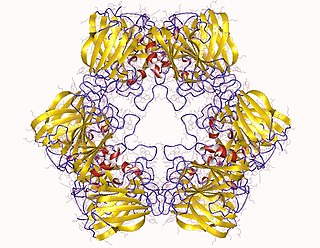The urea cycle (also known as the ornithine cycle) is a cycle of biochemical reactions that produces urea (NH2)2CO from ammonia (NH3). Animals that use this cycle, mainly amphibians and mammals, are called ureotelic.
D-arginase (EC 3.5.3.10) is an enzyme with systematic name D-arginine amidinohydrolase. This enzyme catalyses the following chemical reaction

L-Arginine:glycine amidinotransferase is the enzyme that catalyses the transfer of an amidino group from L-arginine to glycine. The products are L-ornithine and glycocyamine, also known as guanidinoacetate, the immediate precursor of creatine. Creatine and its phosphorylated form play a central role in the energy metabolism of muscle and nerve tissues. Creatine is in highest concentrations in the skeletal muscle, heart, spermatozoa and photoreceptor cells. Creatine helps buffer the rapid changes in ADP/ATP ratio in muscle and nerve cells during active periods. Creatine is also synthesized in other tissues, such as pancreas, kidneys, and liver, where amidinotransferase is located in the cytoplasm, including the intermembrane space of the mitochondria, of the cells that make up those tissues.

In enzymology, an agmatinase (EC 3.5.3.11) is an enzyme that catalyzes the chemical reaction
In enzymology, an agmatine deiminase (EC 3.5.3.12) is an enzyme that catalyzes the chemical reaction
In enzymology, an allantoate deiminase (EC 3.5.3.9) is an enzyme that catalyzes the chemical reaction

Allantoicase is an enzyme (EC 3.5.3.4) that in humans is encoded by the ALLC gene. Allantoicase catalyzes the chemical reaction
In enzymology, an allophanate hydrolase (EC 3.5.1.54) is an enzyme that catalyzes the chemical reaction

In enzymology, an amidase (EC 3.5.1.4, acylamidase, acylase (misleading), amidohydrolase (ambiguous), deaminase (ambiguous), fatty acylamidase, N-acetylaminohydrolase (ambiguous)) is an enzyme that catalyzes the hydrolysis of an amide. In this way, the two substrates of this enzyme are an amide and H2O, whereas its two products are monocarboxylate and NH3.
In enzymology, an amidinoaspartase (EC 3.5.3.14) is an enzyme that catalyzes the chemical reaction

In enzymology, a creatinase (EC 3.5.3.3) is an enzyme that catalyzes the chemical reaction
In enzymology, a diguanidinobutanase (EC 3.5.3.20) is an enzyme that catalyzes the chemical reaction
In enzymology, a gamma-glutamyl-gamma-aminobutyrate hydrolase (EC 3.5.1.94) is an enzyme that catalyzes the chemical reaction
In enzymology, a glutathionylspermidine amidase (EC 3.5.1.78) is an enzyme that catalyzes the chemical reaction
In enzymology, a guanidinobutyrase (EC 3.5.3.7) is an enzyme that catalyzes the chemical reaction
In enzymology, a guanidinopropionase (EC 3.5.3.17) is an enzyme that catalyzes the chemical reaction
In enzymology, a methylguanidinase (EC 3.5.3.16) is an enzyme that catalyzes the chemical reaction
In enzymology, a N-carbamoylputrescine amidase (EC 3.5.1.53) is an enzyme that catalyzes the chemical reaction
In enzymology, a N-malonylurea hydrolase (EC 3.5.1.95) is an enzyme that catalyzes the chemical reaction
In enzymology, a proclavaminate amidinohydrolase (EC 3.5.3.22) is an enzyme that catalyzes the chemical reaction





